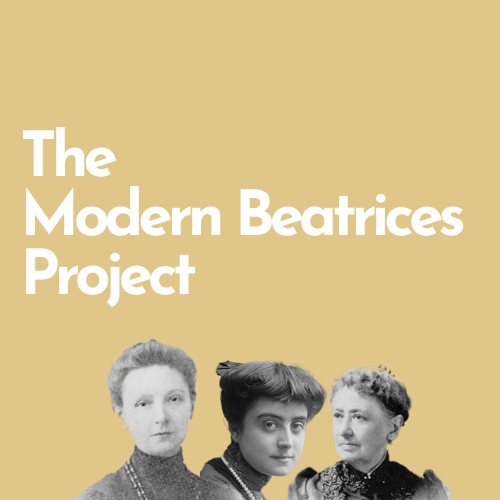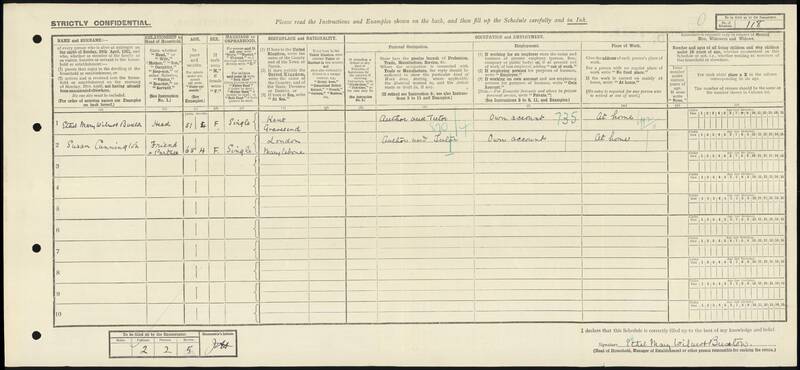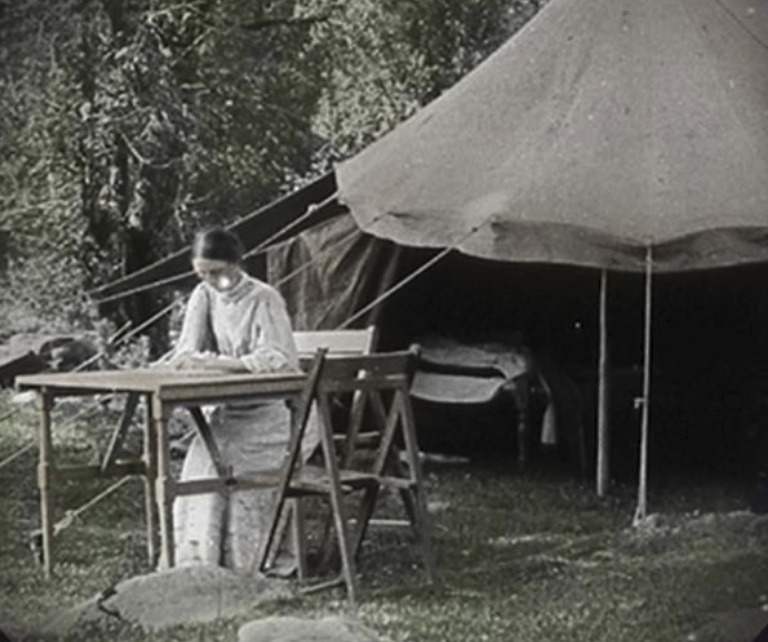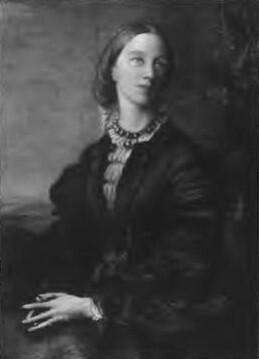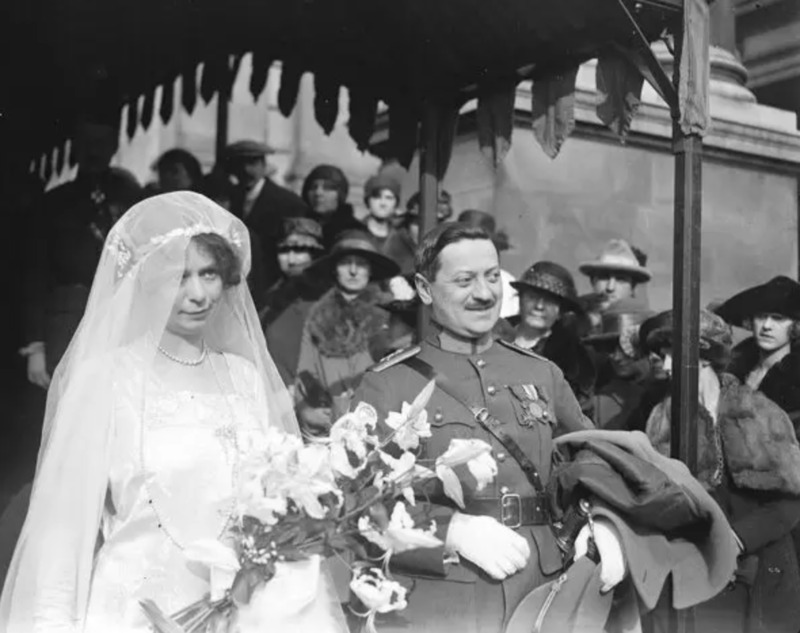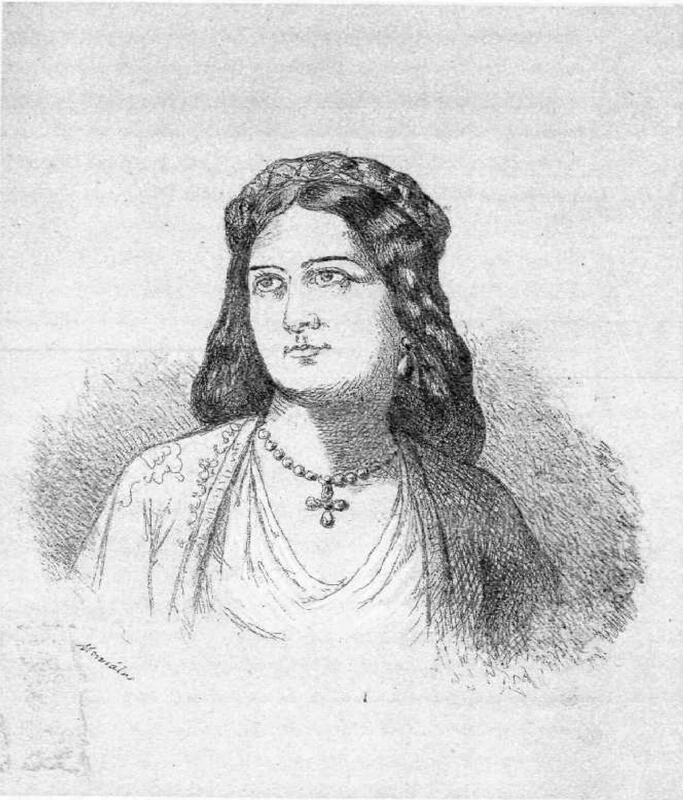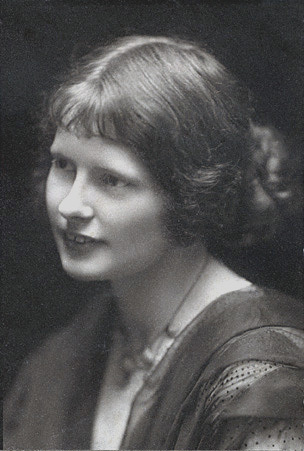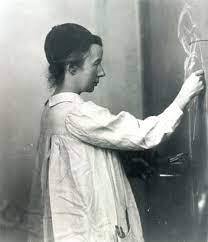
-
Andrews, Marian [née Hare] (1839–1929)Marian Andrews was born at 1 Pelham Place, Brompton, London, on 24 February 1839, the eldest child in the family of four daughters and four sons of the political reformer Thomas Hare (1806–1891) and his wife Mary, née Samson (d. 1855). Marian Hare’s early homes were in Pelham Place, Brompton, and Chestnut Cottage at Ham in Surrey, before the family settled at Gosbury Hill, Hook, Surrey. Her father was a barrister, best known for his support for proportional representation and his close friendship with John Stuart Mill. Like her sisters, Marian Hare was educated at home.
-
Brainbrigge, Marion Sophia (1849-1928)Born 17 December 1849 and baptised at Woolwich, 6 February 1850. In 1921 Census her sister Edith recorded her occupation as "authoress". She died unmarried on 11 December 1928; will proved 23 January 1929 (estate £3,949).
-
Cotes, Rosemary Augusta (1861-1914)Her father, Rev. Septimus Cotes, was the Rector of Newington in Oxfordshore. She had a brother, Everard Charles Cotes who was an entomologist who worked at the Indian Museum in Calcutta. He later became a journalist after marrying the famous Canadian journalist, novelist and playwright Sara Jeannette Duncan. She died unmarried in Oxford on December 18, 1914. Effects £ 135 16s 1d.
-
Coulson, Elizabeth Kerr (1819-1876)She was an English novelist who published under the pseudonym Roxburghe Lothian. Her two-volume work of historical fiction, Dante and Beatrice from 1282 to 1290: A Romance, was published only three weeks before her death. Her fictionalized autobiography Lizzie Lothian appeared posthumously. She died at Bellaport Old Hall, near the village of Norton in Hales in Shropshire. Her two-volume work of historical fiction, Dante and Beatrice from 1282 to 1290: A Romance (based on the lives of Dante Alighieri and Beatrice Portinari), was published only three weeks before her death. Reviews were mixed; The Edinburgh Review noted that the author, assumed to be a man, showed "keen appreciation of the social aspects of Florentine life at this period, with its vivid contrasts of light and shade." Lothian's "gifts of deep feeling and sympathetic fancy" combined with "careful antiquarian study" were praised, though it was admitted that the characters are "somewhat fantastical."[1] The British Quarterly Review likewise acknowledged the book's antiquarian value as a "handbook" of the period's "manners, customs, literature, laws, religion, architecture." The biographical facts pertaining to Dante and Beatrice's lives, however, are handled with fictional licence, sometimes to the point of contradiction. The author is praised for "his" learning, productive effort, and descriptive powers, but the anonymous reviewer concludes that "dramatic imagination is altogether wanting" and "the book is a museum rather than a stage."
-
Evershed Acworth, Mary [née Orr] (1867–1949)Mary Acworth Orr was, astronomer and literary scholar, was born on 1 January 1867 at Plymouth Hoe, the fifth child and third daughter of Andrew Orr (d. 1870), an officer in the Royal Artillery, and his wife, Lucy Acworth. Her father died when she was only three years old and the family went to live with their maternal grandfather, a priest in the Church of England, first at Wimborne and then at South Stoke near Bath. Mary and her youngest sister, Lucy, the close companion of her childhood, were educated entirely at home. When Mary was twenty the two sisters travelled abroad to study languages and the arts. They spent the years 1888–90 in Florence where they began studying the work of Dante and where Mary, who from an early age had an interest in astronomy, became fascinated by the astronomical references in Dante's poetry. Following this, their mother and all four daughters lived for five years in Australia, near Sydney in New South Wales, where Mary got to know the astronomer John Tebbutt at his observatory at Windsor. Finding that there existed no simple star charts of the southern sky she produced An Easy Guide to the Southern Stars (1897) with a foreword by Tebbutt. The Orr family returned to England in 1895. Mary, already since 1891 a member of the Astronomical Society of the Pacific, joined the British Astronomical Association in London and strove to become a serious amateur observer. From 1900 onwards at her home in Frimley, Surrey, she used a 3 in. refractor to make observations of variable stars; she appeared in Stroobant's list of the world's astronomers compiled for the year 1902. In 1906 plans were afoot for Miss Orr to work with E. T. Whitaker, whose wife was a cousin of hers, at Dunsink observatory, Dublin, presumably on a voluntary basis. These came to nothing with her marriage to John Evershed (1864–1956), whom she had first met in 1896 on the British Astronomical Association's clouded-out eclipse expedition to Norway. She moved with him to India on his appointment as assistant director of the Kodaikanal observatory. The Eversheds spent the years 1906–23 in Kodaikanal, Evershed being promoted to director of the observatory in 1911. The observatory was entirely devoted to solar work in which Mrs Evershed, though not a formal member of staff, took a keen interest. She published in 1913 an important paper on active solar prominences, illustrated with a number of fine spectroheliograms. She also acted as her husband's assistant on an expedition to observe the total solar eclipse of 1922 in Australia, and on his expeditions to Kashmir and to New Zealand to test astronomical observing sites.
-
Gurney Russell, Emelia [née Batten] (1823-1894)Early life and marriage
-
Meeus, Marie Louise Egerton Castle, comtesse de ( 1885-1969)Marie Louise Egerton Castle was the daughter of Agnes Mary Frances Sweetman and Egerton Castle. They married in 1883 and co-authored many novels with her husband. Her mother also wrote plays for children, as well as stories for magazines such as Temple Bar, Cornhill Magazine, and Macmillan. Egerton Castle M.A., F.S.A. (12 March 1858 – 16 September 1920) was an author, antiquarian, and swordsman, and an early practitioner of reconstructed historical fencing, frequently in collaboration with his colleague Captain Alfred Hutton. He was born in London into a wealthy family; his maternal grandfather was the publishing magnate and philanthropist Egerton Smith.
-
Mignaty, Albana Margherita (1827-1887)Margherita Albana was born in Corfu, then a British protectorate, to Demetrio Albana and Caterina di Niccolò Palatino, the elder sister of two brothers. Her date of birth is uncertain: according to Angelo De Gubernatis, it was around 1827; for Edouard Schuré it was in 1831. The two biographers, however, linked to her by intense romantic relationships are not reliable. Her maternal aunt, Nina Palatianò, married an English gentleman, Sir Frederick Adam, high commissioner for the Ionian Islands, and together they were able to adopt their niece. They took her with them to India, where they stayed between 1832 and 1837, the period in which Adam was the governor of Madras. After the family moved to Rome, she met Giorgio Mignaty, a painter originally from Cephalonia, and married him in the early 1840s, settling with him in various Italian cities, including Venice and, eventually, around 1844-45, in Florence. The couple had three children: two, Demetrio Federick and Elena, died at eighteen months (1846) and five years (1853) respectively. The other, Aspasia, was an amateur painter and remained close to her mother until her passing. Margherita wrote and spoke fluent English, French, Greek, and Italian; she inserted herself easily into Florentine social and worldly; her salon in Via Larga (later Via Cavour) was a meeting point for foreigners and intellectuals passing through the city. Among the many exponents of the local liberal elite who constituted a point of contact between the moderate right and a more mobile and vast area of opinion were Ubaldino Peruzzi, Francesco Dall’Ongaro, Angelo De Gubernatis. Margherita was a friend and confidant of the historian Pasquale Villari, and became a writer in the very years in which Villari obtained the Chair of Modern History in Florence. During the years of unification, Margherita fervently supported the Italian cause, writing popular Florentine correspondence for The Daily News from 1859 to 1866. As a Greek noblewoman writing from Florence in favour of Italian independence, she embodied the romantic myth of the nation in the eyes of English public opinion, thanks to an ideal unification of Greece, for which Byron had died fighting. In her correspondence, she gave an account of political events, expressing favourable expressions of the spirit and the character of the Italian people, to correct the negative opinion of English readers. She was the first to publish the state of public education in Italy, writing for Rivista di Firenze (Florence Magazine), run by Atto Vannucci, about fellow countrymen Shelley and Byron. In 1865, she printed “a historical sketch illustrative of the life and times of Dante Alighieri, with an outline of the legendary history of Hell, Purgatory and Paradise previous to the Divina Commedia” (A. Bertini, Florence 1865). She was interested in the works of Wagner and wrote “Le theatre de Beyrouth et la Reforme musicale de R. Wagner” (“The Beirut Theatre and the Musical Reform of R. Wagner”) (1873), where she explained the philosophical as much as the technical side of the composer’s work. In line with her interests in Italy’s history and with the English taste for its Renaissance past, she dedicated her “sketches of the historical past of Italy” (Bentley, London 1876) to Lord Gladstone. Also dating back from the sixties was her intense relationship with Edouard Schuré, the Alsatian philosopher with whom she shared a passion for Wagner’s music, Italian art and occultism. Schuré dedicated a chapter to her in his “Donne Ispiratrici” (“Inspirational Women”) (Paris 1930), and kept up correspondence with her husband even after his muse’s death. In 1881, she published “Le Corrège, sa vie et son oeuvre” (“Correggio, His Life and Work”) (Fischbacher, Paris 1881), a treatise on practical aesthetics, thanks to which she was awarded honorary citizenship of the city, in whose civic collections one can also find a self-portrait of her. Margherita died in Livorno on 20th September 1887; her body received public honours and was displayed in a room in Florence Station, where Eduard Schuré and Angelo De Gubernatis recited a eulogy. She is buried in the Protestant cemetery at Porta Romana.
-
Paul, Evelyn (1883 – 1963)Evelyn Maude Blanche Paul was born on 4 November 1883, at 30 Torriano Avenue, Kentish Town, in North London. Her father was the portraitist Robert Boyd Paul (1819–1903), and her mother was Annie née McGlashan (born 1858 at Gibraltar), the daughter of a sergeant in the Royal Artillery and Robert Paul's 2nd wife. In her teens, Evelyn attended art school in London and in 1906 entered the Schools of Art National Competition. She continued her studies, and on 1 June 1911 married the artist Alexander George Small (1875-1923), son of William Small (1843-1929), a well-known painter and honorary Fellow of the Royal Scottish Academy. Alexander died twelve years later in 1923 at St Pancras Hospital, London, at the age of 48. Evelyn died of broncho-pneumonia at the same hospital on 29 January 1963.
-
Phillimore, Catherine Mary (1847-1929)Catherine Phillimore was born Shiplake House near Henley-on-Thames, Oxfordshire. She was the eldest daughter of Robert Phillimore, known as Sir Walter Phillimore, 2nd Baronet, from 1885 to 1918, a British lawyer and judge. A close friend of William Gladstone, he was the person who initially gave to his wife Catherine Glynn at Rome in 1839 the the Comino ‘pocket Dante' edition, which the Prime minister minutely annotated throughout his life.
-
Potter, Caroline (1874-1919)Little is known about Catherine Potter. She lived and work as a machinist in Manchester, Lancashire.
-
Sayers, Elizabeth Pryce (1836-1917)Elizabeth Price Sayers was born in St Nicholas, Isle of Wight, Isle of Wight & Hampshire, England, in 1836. She never married.
-
Selfe, Rose Emily (1863-1929)Rose E. Selfe was born in 1863. She contributed articles in the Journal of Education, the Monthly Packet of Evening News. She was the author of translations, children adaptations, biographies and studies.
-
Traquair, Phoebe Anna [née Moss] (1852-1936)Phoebe Anna Moss was born into a Dublin medical family and studied art with the Royal Dublin Society. She moved to Edinburgh in 1874 with her husband Dr Ramsay Traquair and they had three children. Initially her art consisted of watercolours and embroidery. Later she illuminated manuscripts, tooled bookcovers and, after 1900, took up enamelling. Public art gave her imagination and ambition an even greater scope. Her first commission came from the Edinburgh Social Union in 1885 for the decoration of a tiny chapel at the first Hospital for Sick Children. This was painted in an eclectic mix of medieval, Byzantine and Pre-Raphaelitism and reflected her interest in the poet-artist William Blake. A second commission, for St Mary’s Cathedral Song School, soon followed and made her name. Critics wrote of her modern colour and extraordinary imagination. In 1904 Phoebe Traquair’s finest embroideries The Progress of a Soul (now in the National Gallery of Scotland) were shown at the World’s Fair in St Louis. Although highly respected, she was turned down for professional membership of the Royal Scottish Academy but finally elected an honorary member in 1920. She died in Edinburgh at the age of eighty-four."
-
Whiting, Mary Bradford (1864-1935)Mary Bradford Whiting was born in 1864 in Bloomfield, Essex, the daughter of the Rev. John Bradford Whiting. Her father was a noted hymn-writer and she also contributed to the genre. She also wrote numerous religious works and novels, mainly for the S.P.C.K. She was a writer and regular contributor to The Bookman, Quiver, Good Words, Temple Bar, The Gentleman's Magazine, Westminister Review, Fortnightly Review, The English Illustrated Magazine, The Young Woman, The Girls own paper. She was a Member of the Ramsgate Women's Local Government Association. She died unmarried in 1935. Effects £ 8,044 11s 8d.
-
Wyld, Marion Alice (1858-1932)Early Life
https://mint-shrew.lnx.warwick.ac.uk/s/dante-s-female-public/item?resource_class_id%5B0%5D=94&item_set_id%5B0%5D=1122&has_markers=&mapping_address=&mapping_radius=&mapping_radius_unit=km&page=1&sort_by=title&sort_order=asc
